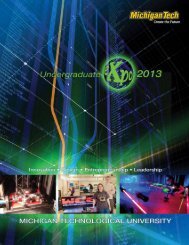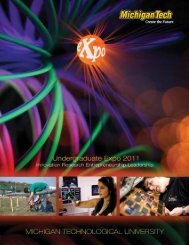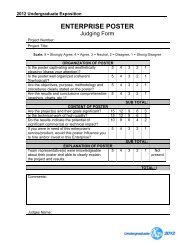Download - Undergraduate Expo - Michigan Technological University
Download - Undergraduate Expo - Michigan Technological University
Download - Undergraduate Expo - Michigan Technological University
Create successful ePaper yourself
Turn your PDF publications into a flip-book with our unique Google optimized e-Paper software.
Senior Design<br />
128<br />
RFID-Based Safety System<br />
129<br />
Remote Water-Sensing Hydrant<br />
130<br />
Bioabsorbable Polymer-Coated<br />
Metal Stent Degradation<br />
Simulation Design<br />
Yan Guo, Mingzi Li, Matt Rathbun, and Bin Zhou<br />
connect a RFID reader to a microcontroller.<br />
Team Members<br />
Jonathon Nelson, Xingbo Song, Zhi Zheng,<br />
Matt Rathbun, Yan Guo, and Xin Hao, Electrical<br />
Engineering; and Michael Mermuys, Mechanical<br />
Engineering<br />
Advisor<br />
Donald Secor<br />
Sponsor<br />
ArcelorMittal<br />
Project Overview<br />
We are planning to design a system that<br />
automatically logs when employees come in or out<br />
of dangerous areas. As the sponsor has requested,<br />
this capability won’t use a card swipe or a twoway<br />
radio. Instead, we will use RFID scanners in<br />
doorways and RFID tags that will be worn or held<br />
by employees. This all depends on the working<br />
environment and the specific needs of the sponsor,<br />
such as what type of RFID device they prefer or<br />
what they need the scanning range to be.<br />
To the left, determining a suitable method for<br />
allowing an antenna to pass through the housing<br />
while the remaining team members; to the right,<br />
attempting to get the transceivers to transmit and<br />
receive the appropriate signals.<br />
Team Members<br />
Adam Geml, Electrical and Computer Engineering;<br />
Michael Mermuys, Mechanical Engineering; Xin<br />
Hao, Jonathon Nelson, Xingbo Song, and Zhi Zeng,<br />
Electrical Engineering<br />
Advisor<br />
Donald Secor<br />
Sponsor<br />
EJ<br />
Project Overview<br />
The scope of this project is focused on the dry<br />
barrel hydrant and creating and packaging a<br />
prototyped sensor to wirelessly transmit a signal if<br />
the hydrant contains water. The goal is to reduce or<br />
eliminate the number of hydrants damaged due to<br />
freezing weather.<br />
Fluorescent polymer-coated wires for<br />
degradation characterization.<br />
Team Members<br />
Kristina Price, Brendan Daun, Thomas Faulkner,<br />
Erin Larson, Derek Yesmunt, and David Strobel,<br />
Biomedical Engineering; and Kelsey Waugh and<br />
Matt Gardeski, Materials Science and Engineering<br />
Advisors<br />
Dr. Jeremy Goldman and Dr. Jaroslaw Drelich<br />
Sponsor<br />
Boston Scientific<br />
Project Overview<br />
The next generation of drug-eluting stents may<br />
contain drug-releasing biodegradable polymer<br />
coatings. However, the biodegradation rates and<br />
behavior of these polymer coatings will first need to<br />
be tailored to meet the needs of diseased arteries.<br />
As an improvement over existing methods, we have<br />
developed low-cost, simplified, and time-effective<br />
methods for characterizing the degradation<br />
behavior of different polymers. These parallel in<br />
vitro and in vivo methods exploit the properties of<br />
fluorescent molecules and utilize simple implant<br />
geometries to characterize degradation rates and<br />
behavior.<br />
Senior Design 2012 • 15






